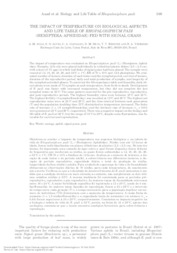The impact of temperature on biological aspects and life table of Rhopalosiphum padi(hemiptera: aphididae) fed with signal grass.
The impact of temperature on biological aspects and life table of Rhopalosiphum padi(hemiptera: aphididae) fed with signal grass.
Author(s): AUAD, A. M.; ALVES, S. O.; CARVALHO, C. A. de; SILVA, D. M. da; RESENDE, T. T. de; VERÍSSIMO, B. A.
Summary: The impact of temperature was evaluated on Rhopalosiphum padi (L.) (Hemiptera: Aphididae). Nymphs, 12-h-old, were placed individually in cylindrical plastic dishes (2.5 × 2.5 cm), with a layer of 1% agar in which leaf disks of signal grass had been placed. The nymphs were reared at 12, 16, 20, 24, 28, and 32°C ± 1°C, RH of 70 ± 10% and 12-h photophase. We evaluated number of instars, duration of each instar and the nymphal period, survival of instars, duration of the reproductive period, daily and total production of nymphs, and longevity of the nymphal and adult phases. To construct the life expectancy table and fecundity, daily observations were made of 70 nymphs at each temperature, from birth to death. Development of R. padi was faster with increased temperature, but they did not complete the last nymphal instar at 32°C. The same pattern occurred for the pre-reproductive, reproductive, and post-reproductive periods. The highest fecundity rates were between 16°C and 24°C. The highest fertility (4 nymphs/female/day) was recorded at 12°C and 20°C. The highest net reproduction rates were at 24°C and 28°C, and the time interval between each generation (T) and the population doubling time (DT) diminished as temperature increased. The finite rate of increase (? = 1.9 nymphs/female/day) and the intrinsic rate of increase (rm = 0.64) were greatest at 24°C and 28°C, respectively. There was a negative impact on the biology and life table of R. padi at 32°C, but the range of 12°C to 28°C, despite some fluctuations, was favorable for survival and reproduction.
Publication year: 2009
Types of publication: Journal article
Unit: Embrapa Dairy Cattle
Keywords: Aphids, Pest, Signal grass, ecology
Observation
Some of Embrapa's publications are published as ePub files. To read them, use or download one of the following free software options to your computer or mobile device. Android: Google Play Books; IOS: iBooks; Windows and Linux: Calibre.
Access other publications
Access the Agricultural Research Database (BDPA) to consult Embrapa's full library collection and records.
Visit Embrapa Bookstore to purchase books and other publications sold by Embrapa.

